Joseph Stuart Henley
Family
Joseph Stuart Henley was born in Dartmouth on 19th December 1893 and baptised at St Saviours on 15th February 1894. He was the youngest (surviving) son of John Joseph Henley and his wife Elizabeth Leighton.
John Joseph Henley was born and brought up in Dartmouth, where his father was one of three "outdoor officers" in the Customs Service, responsible for collecting customs duties. John Joseph became a shipwright; by the time of the 1881 Census, he had moved to Southampton to pursue his trade, where he lodged with another shipwright from Dartmouth, Thomas Fox, in Guildford Street. In Southampton, he met his wife Elizabeth Leighton (sometimes recorded as Layton), who was born in Pauntley, Gloucestershire. They were married on 2nd September 1883 at Christ Church, Northam (where there were several shipbuilding yards).
John Joseph and Elizabeth made their home in Southampton, where their first two children, Ina Elizabeth Violet, and John Pearce Leighton, were born in 1884 and 1886. However, by the time of the birth of their third child, Eva Mary Leighton, in 1888, they had moved back to Dartmouth. In 1891 they lived in Crowthers Hill - John Joseph continued to work in the shipbuilding industry as a shipwright. Their fourth child, Henry Bertie, was born a few days after the 1891 Census, on 29th April 1891, and baptised on 18th June at St Saviours; Joseph Stuart followed a little under three years later.
The couple's last two children were twins, William Jack and Louisa Rose, born in Crowthers Hill on 6th December 1896 and baptised at St Saviours on 23rd December. Very sadly, William died the following day. The 1901 Census recorded the family in Crowthers Hill. The two eldest children were in work - Ina, now 17, was living away from home in Exeter, where she worked as a kitchenmaid in Duryard House (now part of the University of Exeter); John (junior) remained in Dartmouth, where he had followed his father into the shipbuilding industry, as a "Time Boy". The four younger children, including Joseph Stuart, were still at school.
By 1911, Joseph, aged 17, had also left home, though he had not gone far. He worked as a footman for Lady Martha Carden, who lived at Ravensbury, in Dartmouth. Joseph boarded in Ravensbury Lodge with Ernest Cowdery, the gardener, and his wife Florence. He was one of eight servants of the household. Lady Carden had sold Ravensbury in 1892, but bought it back in 1909, having lived for some time in other houses in the neighbourhood, including Gunfield, Sandridge Park, and Riversea, in Kingswear. However, Lady Carden died suddenly in July 1911, so Joseph may have had to find other employment, when the house was sold.
Service
Joseph's individual army service record, like so many, has not survived, so his story has to be pieced together from various pieces of information from a number of sources. The name "Pte J Henley" appears in the list of the members of "F" Company (Dartmouth) 7th Battalion Devonshire Regiment (Cyclists), published in the Dartmouth Chronicle on 25th September 1914, part of the newspaper's attempt during the first years of the war to record all those from the town serving with the Forces. This early date suggests that he may possibly have enlisted in the Territorial Force before the outbreak of war (several men from Dartmouth joined the Cyclists in the first few weeks of the war, and their names were published in the newspaper on 16th October 1914). If so, he will have been mobilised when the war began.
For the early history of the Devon Cyclists, see the story of Frederick Thomas Bell. Sent to the north-east of England for coastal defence duties, the 7th Devons were involved in the rescue effort for the hospital ship Rohilla, wrecked off Whitby in October. They then assisted with civilian casualties after the shelling of Scarborough, Hartlepool and Whitby by the German Navy in December. The year 1915 was spent in Devon and Kent, on coastal defence and assistance to the civil powers as required; in 1916 their area of operations was extended into Suffolk.
Although the Battalion as such never left England, the introduction of conscription in 1916 meant that the requirement to honour the restriction on overseas service for men in the Territorial Force no longer applied. According to a social media site commemorating the 8th Worcesters (see sources below) a large contingent from the Devon Cyclists transferred in May 1916 to serve with the Worcestershire Regiment, to bring numbers up to the required level for service in France.
From other records, we can infer that one of them was Joseph. The British War and Victory Medal Roll of the Worcestershire Regiment shows that he served first with the 2nd/8th Battalion, and then with the 4th Battalion; and that his service number on joining the Regiment was 5537. This is very close to the numbers of two other Dartmouth men, 5559 Private Frederick Coles, who was also in "F" Company 7th Devons, and whom we know, from his service records, transferred in May 1916 to the 2nd/8th Worcesters; and 5568 Sergeant Patrick Lyons whose service in the 7th Devons was recorded in Dartmouth at the time of his death in August 1916.
The Devon Cyclists transferring to 2nd/8th Worcesters soon found themselves on their way to the front line. They landed at Le Havre on 25th May 1916 with the rest of the Battalion, part of 61st Division; by 1st June 1916, they had arrived in the trenches at Neuve Chapelle for ten days of instruction in trench warfare from 105 Brigade. Then, while a party of 45 went off for further instruction with a Tunnelling Company of the Royal Engineers, the rest took over another section of the front line nearby for four days.
Their first tour of duty in the trenches on their own was not without incident - on 12th June one man was killed (the Battalion War Diary states by accident, but does not give details; other reports state that he was killed by shrapnel) and two were wounded; on 14th June, at 8.20am, an enemy bombing party attacked at a position known as Ducks Bill Crater, and two men were killed and one wounded. All three men killed in June were ex-Devon Cyclists.
At midnight that night, the British exploded a mine under the German line, with artillery support, machine gun and rifle fire, and the enemy responded "occasionally" with artillery, until 1am. As the Battalion was relieved in the trenches, another man was wounded.
From 16th June to 9th July the Battalion was in divisional reserve, in billets, undergoing further training on the rifle ranges and providing working parties. Wiring and Bombing parties also received training. On 20th June, one man on a working party was wounded.
It seems that Joseph must have been one of those wounded during June, because a surviving fragment of a "sick and wounded list" states that he was admitted to the 2nd Northern General Hospital, at Beckett's Park, in Leeds, on 12th July 1916. The list simply describes him as "wounded", without any further detail; but it must have been quite serious for him to have been evacuated to England. His name appeared in a casualty list published 5th August 1916 as "wounded"; and from this we know that he was already ranked Corporal - it seems likely that he had achieved this rank at the time of his transfer into the Worcestershire Regiment.
Joseph was most probably transferred to the 4th Battalion Worcestershire Regiment after recovering from his wound. When he rejoined them is unknown. The 4th Battalion (one of four regular battalions of the Regiment), part of 29th Division, had spent most of the last three months of 1916 on the Somme but by the end of the year were well behind the line in camp at Molliens, west of Amiens, resting and training. They returned to the Somme front line at Morval in January, moving in February to Saillisel. On 3rd March 1917, they left the front line and moved to the rear, to Méaulte.
The Battalion War Diary does not explicitly say so, but due to the German withdrawal to the Hindenburg Line between 16th-19th March 1917, plans changed rapidly. "Baths and services" were cancelled as forces were assembled for the new spring offensive at Arras. That evening they were back in their previous billets at Molliens, and resumed fairly intense training. They began their move up to Arras on 29th March, marching all the way. By 7th April they had reached Couturelle, south-west of Arras; and were held there for five days.
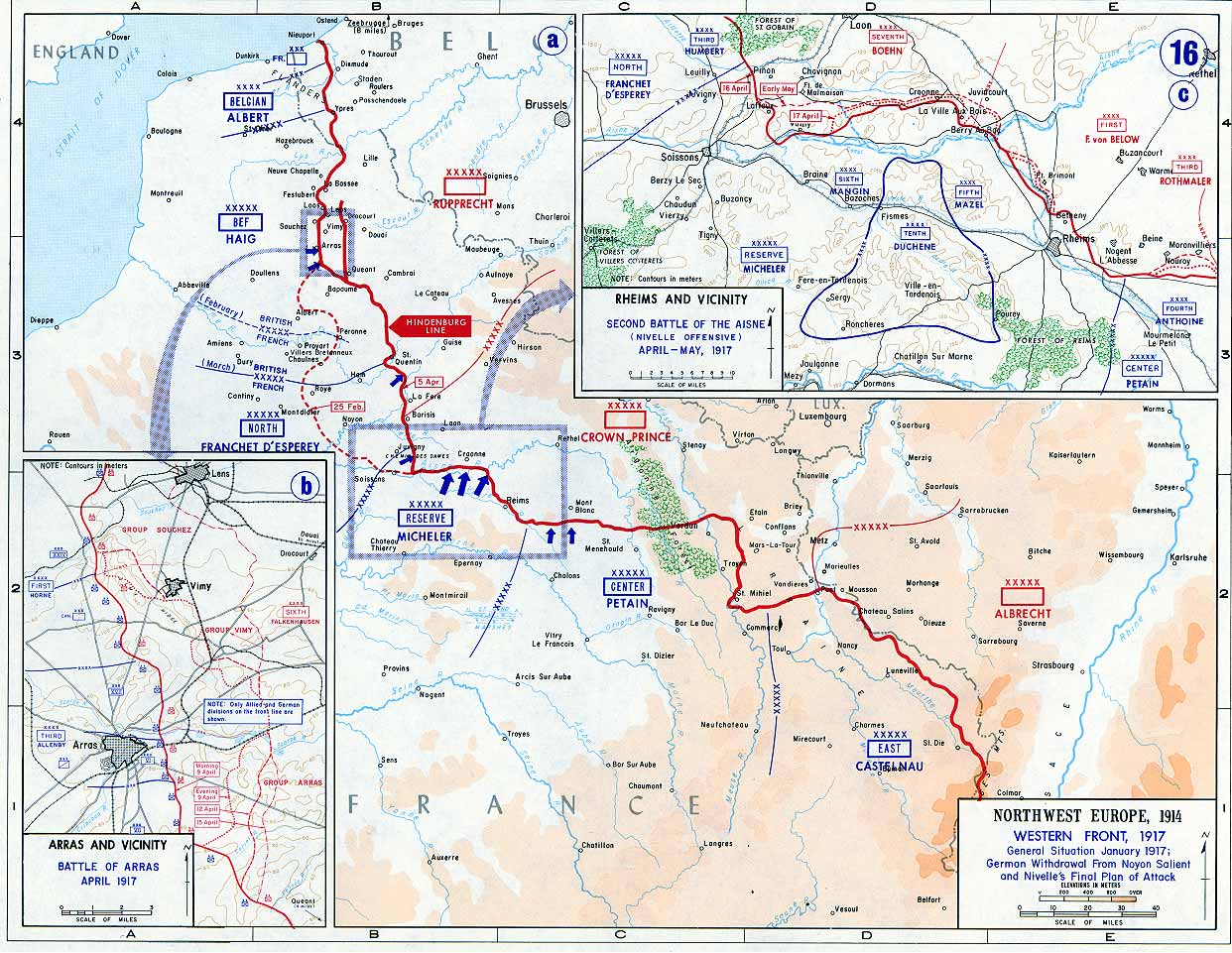
The Battle of Arras
For the background to the Battle of Arras, and a brief account of the successful action between 9th-11th April, see the story of Cyril Stafford. The 29th Division was in reserve for the initial attack on 9th April, and the 4th Worcesters had orders to move at six hours notice; on 11th April, they were still at Couturelle, with orders to move at two hours notice.
On 12th April, they were brought into the battle. The War Diary records that they marched through Arras and, by 6.30pm, down the Cambrai road to the Feuchy Chapel crossroads where they were met by guides who led companies to their respective trenches south of the village of Monchy-le-Preux and just east of the village of La Bergere. In the middle of the night they relieved the 11th Middlesex Regiment - the relief took a long time because "the Cambrai road was much congested with traffic".
In the morning, they received orders to attack at 2pm, the Battalion to be in reserve, but this was cancelled, because the jumping-off trench had not been dug the previous night. At 5.30pm, the 3rd Division, on the Battalion's right, attacked south of the Cambrai road, opposite the village of Guemappe - the village was taken, but reoccupied by the enemy following a counter-attack. "Z" Company, on the right of the Battalion's position and in touch with the fighting as British troops retired, suffered seven casualties during the counter-attack.
At 2am on 14th April, the Battalion moved slightly to the north; "W" Company, with part of "Y", took over positions previously occupied by the Newfoundland Regiment; the remainder of "Y" took over "W"'s previous position, and so on. Meanwhile, the 1st Essex and Newfoundland Regiment prepared to attack on the eastern outskirts of the village of Monchy. According to the account of the action on the website of the Royal Newfoundland Regiment (see sources below):
The small force [of two Battalions] was to advance, unsupported on the flanks, against a position which when captured would form a salient, and hold it against possible counter-attack by incalculable numbers of the enemy ... There was general agreement afterwards that the barrage had been deplorably thin ... It failed to silence the enemy's machine guns [and] within minutes the Germans replied to the British artillery with their own barrage ... as the Newfoundlanders advanced, casualties came rapidly ...
Initial objectives were gained, but as the attack was pressed forward, it was overwhelmed:
Counter-attacked from three sides and with no sign of reinforcements, the survivors of the Newfoundlanders put up a desperate struggle against impossible odds ... with the enemy only fifty yards away they were forced to surrender ... the survivors of the platoons manning the strong points tried to retire but very few escaped ...
The three attacking companies of the 1st Battalion of the Essex Regiment were also overwhelmed. Their War Diary states:
By 7.30am the counter-attack had fully developed in all its strength of at least nine battalions. The weight of the attack seems to have come from the North East and thus fell on "X" Company [on the flank]. This Company in spite of a stout resistance was gradually overwhelmed. From 7.30am onwards no reports, messages or wounded men arrived at Bn Hqrs or the Aid Post. It is therefore apparent that "X" Company having been overrun the hostile forces got between Monchy and the attacking Companies of the Essex and Newfoundland. No men have returned from these Companies.
According to the Newfoundland Regiment's account, however, one man from the Essex Regiment did get back to the Newfoundland Headquarters in Monchy to give the news that all his Battalion were either killed or captured. With no news coming back from his own companies, the Newfoundland Regiment Commanding Officer, Lt Col Forbes Robertson, sent out his signals officer to reconnoitre, who reported that "there was not a single unwounded Newfoundlander east of Monchy le Preux, and that ... some 200 to 300 Germans [were] advancing in extended order less than a quarter a mile away". The CO assembled what men he could and began a heroic defence of Monchy with rapid and well-directed fire from behind a well-banked hedge, half-way between the village and the trenches from which the attack had been launched that morning.
Eventually Lt Col Forbes Robertson was able to get a message through to Brigade Headquarters with an urgent request for reinforcements and a request for artillery fire; reserves arrived in Monchy at 2.45pm and a barrage was put down to the east of the village.
In the meantime, the 4th Worcesters had come into the action to the south. Their Battalion War Diary describes the action in slightly different terms, as they saw it from their part of the line:
At 5.30am these battalions [1st Essex and Newfoundland Regiment] advanced under cover of a barrage and gained their objective. At 10am about 2000 Germans were seen advancing towards us with small parties of our troops retiring before them. The artillery was informed and barrage fire immediately opened. When the retreating troops had cleared our front W Coy opened fire with rifles and Lewis Guns, and the attack was completely shattered by 12.30pm, although the enemy reached a point within 100ft of our trenches. After this Z Coy was moved up in support of W in case of another attack.
Thus the counter-attack failed, and Monchy was held; but at huge cost. Newfoundland Regiment losses from 12-15 April totalled 460 all ranks: 166 killed or died of wounds; 141 wounded; and 153 taken prisoner, of whom 28 later died of wounds or of other causes while in captivity. The War Diary of the 1st Essex recorded total casualties of 661 all ranks killed, injured or missing; 208 were taken as prisoners, many of whom were injured, of whom 16 later died in captivity.
These losses were so great that a combined battalion had temporarily to be formed with the remnants, named the 1st Newfoundessex, comprising only 400 men.
The losses suffered by the 4th Worcesters were far fewer, as they had not participated directly in the initial attack, but they nonetheless totalled 54 - four officers wounded, one of whom died of wounds, and 50 men killed or wounded.
The 4th Worcesters were relieved the following day and marched back to billets in Ronville, a suburb to the west of Arras. After a short rest, they were moved forward on 19th April as far as the Reserve trenches south of the Cambrai Road, which, as they were just in front of the positions of the heavy artillery, "came in for a good deal of intermittent shelling". On 20th April, one officer was killed and three wounded; 20 men were killed or wounded; on 21st April, a second officer was killed, and a further nine men were killed or wounded. As they moved forward to the front line that night, a further thirteen men were killed or wounded.
Death
All available records state that Joseph died of wounds on 21st April 1917. When he was wounded is not known - from the War Diary's account of the Battalion's activities, it may have been the 13th, 14th, 20th or (perhaps less likely) the 21st itself.
News of his death reached Dartmouth fairly quickly. The Dartmouth Chronicle of 11th May 1917 carried two announcements, one from his parents, and one from his "sweetheart" Beatrice:
Henley: April 21st, died of wounds received in action in France, Cpl Joe Henley, Devon Rgt, youngest son of Mr and Mrs Henley, Waterpool Road
(Beatrice may have been Beatrice May Badge, aged 19 in the 1911 Census, one of two servants in the household of Thomas Wilton, Mayor of Dartmouth, who lived at Hawarden, South Town).
His brother and sisters placed an announcement the following week:
Henley: April 21st, died of wounds in France, "Joe" Henley, dearly loved brother of Bert, Ina, Eve, Rose, and little Niece Joanne Kelland
Commemoration
Joseph is buried in the Faubourg D'Amiens cemetery in Arras, close to where the 4th Worcesters had been in action. This cemetery was begun in March 1916 when Arras was handed over by the French to Commonwealth forces. According to the Commonwealth War Graves Commission, the cemetery continued to be used by field ambulances and fighting units until the Armistice, and was then further enlarged as graves were brought in from the battlefields.
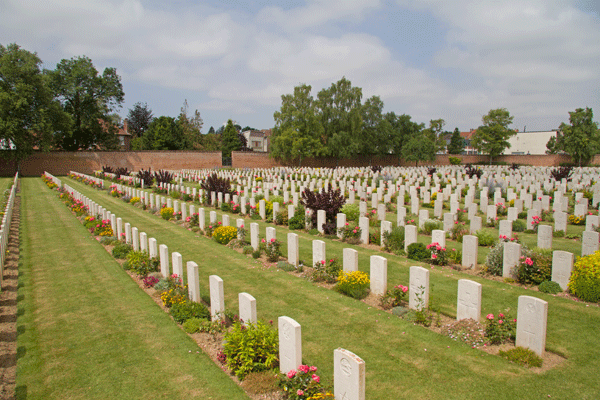
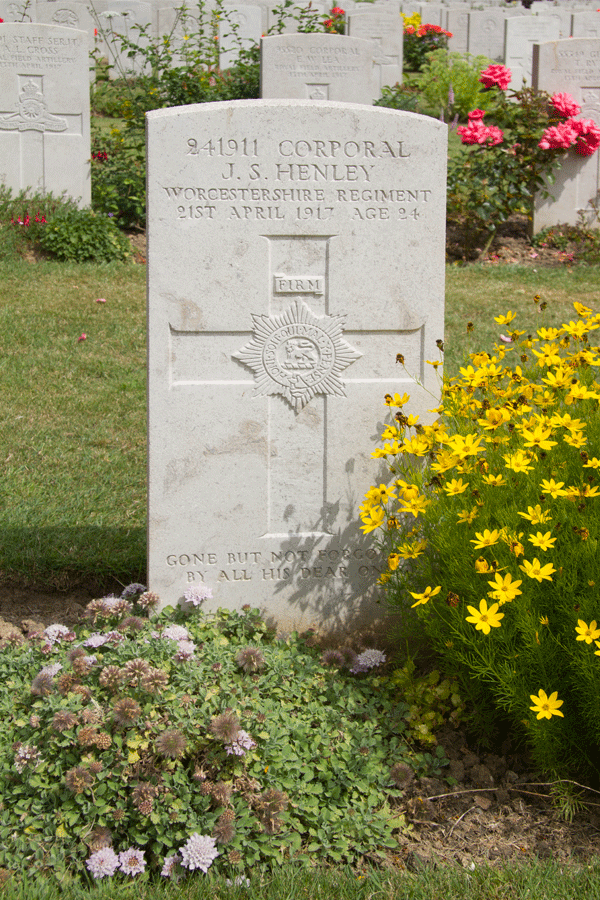
As one of the 579,206 casualties in the region of Nord-Pas-de-Calais, Joseph is also commemorated on the new memorial at Notre Dame de Lorette, "The Ring of Memory".

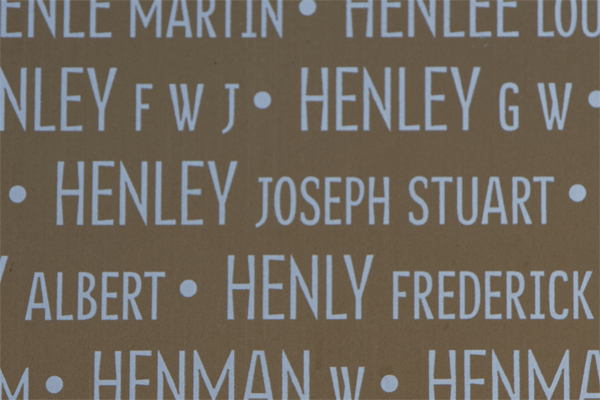
In Dartmouth, he is commemorated on the Town War Memorial, and the St Saviours War Memorial Board.
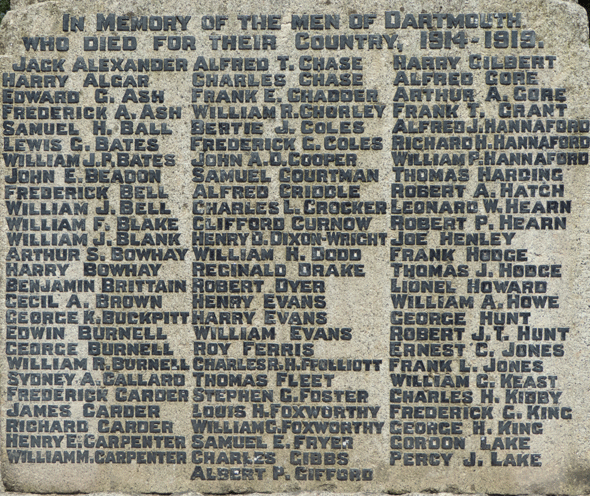
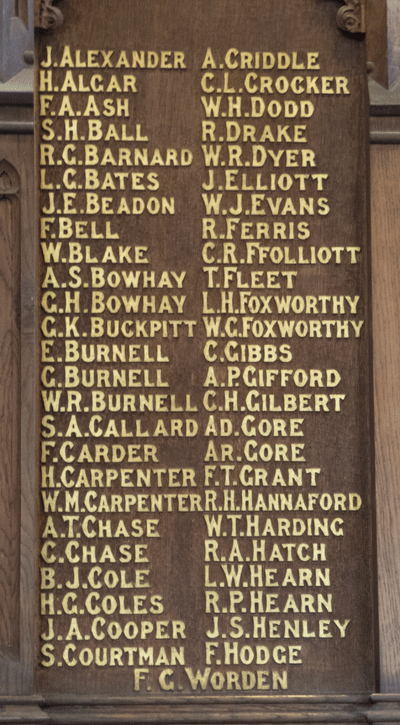
Sources
War Diary of the 2nd/8th Worcestershire Regiment, 1915 September - 1918 January, downloadable from the National Archives, fee payable, reference WO 95/3060/4
War Diary of the 4th Battalion Worcestershire Regiment, 1st March 1916 - 30th April 1919, downloadable from the National Archives, fee payable, reference WO 95/2309/2
War Diary of the 1st Battalion Essex Regiment, 1st March 1916 - 31st January 1918, downloadable from the National Archives, fee payable, reference WO 95/2309/1
The Royal Newfoundland Regiment, Monchy-le-Preux, 14th April 1917
The Essex Regiment, Monchy-le-Preux, 14th April 1917
Information Held on Database
| Surname: | Henley |
| Forenames: | Joseph Stuart |
| Alternative Forenames: | Joe |
| Rank: | Corporal |
| Service Number: | 241911 |
| Military Unit: | 4th Bn Worcestershire Regiment |
| Date of Death: | 21 Apr 1917 |
| Age at Death: | 23 |
| Cause of Death: | Died of wounds |
| Action Resulting in Death: | Battle of Arras |
| Place of Death: | Arras, France |
| Place of Burial: | Faubourg D'Amiens cemetery, Arras |
| Born or Lived in Dartmouth? | Yes |
| On Dartmouth War Memorial? | Yes |
| On St Saviour's Memorials? | Yes |
| On St Petrox Memorials? | No |
| On Flavel Church Memorials? | No |
| In Longcross Cemetery? | No |
| In St Clement's Churchyard? | No |
| On a Private Memorial? | No |
| On Another Memorial? | No |















